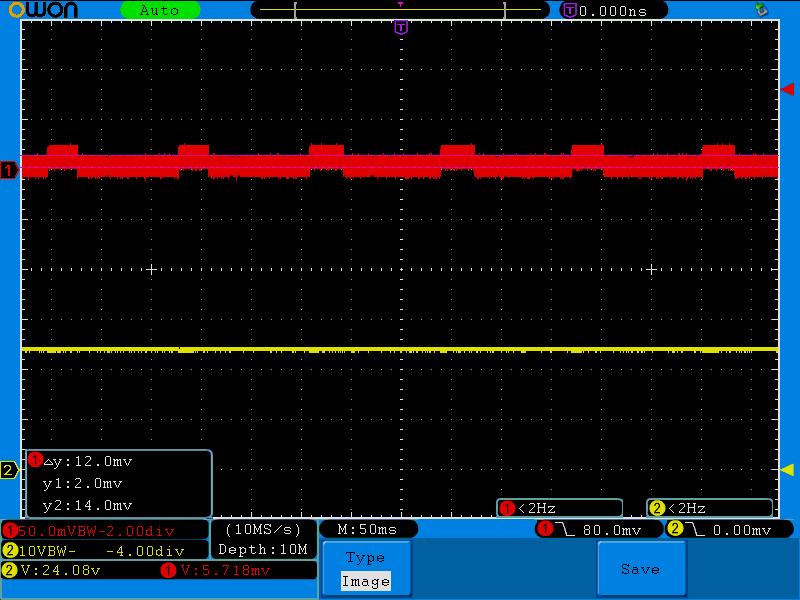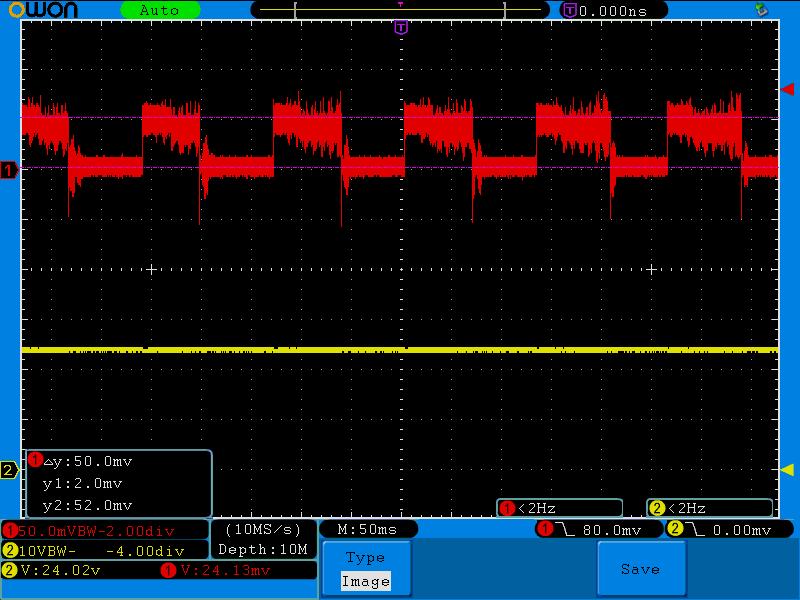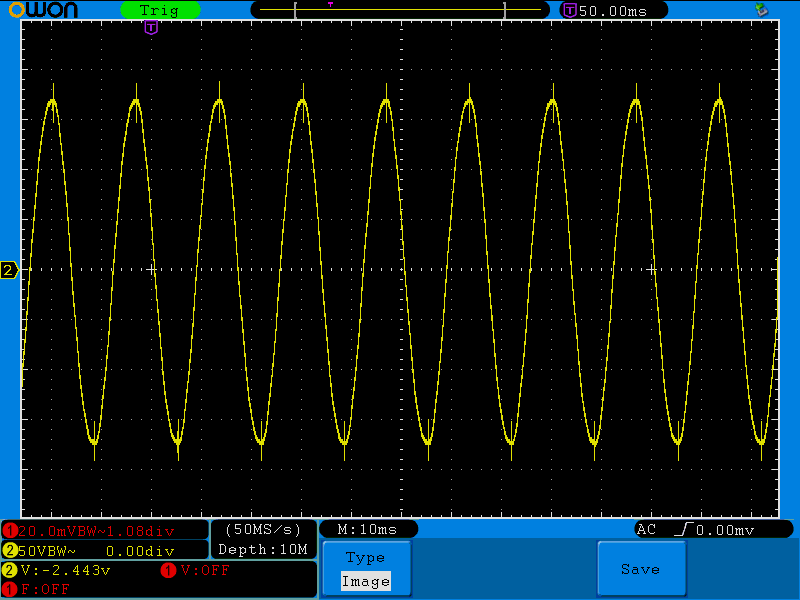Re: Power Supply failure
Holy crap! 4 days in myself and my power supply just shit the bed on me. I went upstairs and before it could even start the bottom layer after doing the perimiter it just stopped.
Talked to support, new Power Supply is being ordered. This doesn't sit right with me as this isn't something that should be happening, especially not 4 days into using the printer 🙁
Re: Power Supply failure
My PSU died after 6 hours of use about 8 days ago. Talked with Prusa and I got a new PSU in today. During that period I was using a Meanwell NES-350-24 PSU as a backup. Worked great with no problems. PSU didn't even get warm. I bought another brand new Meanwell SP-480-24 on ebay for $30 shipped.
Does anyone have a schematic of Prusa's 240w PSU? Which components seem to be failing? My thermistor appears to be OK and my R4 resister appears OK but reads ZERO.
Jim
Re: Power Supply failure
I finished a mk3 build @ ~2100 last Saturday night and the PSU burned out around ~1000 Tuesday morning while printing PETG. Iddly, it happened while actively printing and not during bed warm up. A 17.5 hour PETG print had finished about an hour prior, so it wasn't the first time the bed had been run that hot. It blew the 5A slow burn fuse in the PSU and tripped the 125v/15A breaker (non-arc fault) it was on. Replacing the fuse with a 5A fast fuse immediately blew, possibly from in-rush? A 5A slow fuse didn't blow but did make a soft pop and release some "magic odor". I emailed Prusa around 1200 my time (UTC-07) and live chatted with tech support around 2300; they said they needed time look at the email. As of 0945 there still hasn't been an email response, which means there's no realistic way a replacement from Prusa could reach me before the weekend.
A 240w psu seems really marginal for this unit. I'm guessing this was selected to avoid requiring an active fan. I do have a bench power supply that will do 24v but it tops out at 150w, so I decided to go ahead and order a 500W Mean-Well UHP-500R-24:
https://www.meanwell.com/webapp/product/search.aspx?prod=UHP-500(R)
I ordered from arrow.com for $90 + tax. This wasn't the lowest price I could find but they do claim overnight free shipping.
https://www.arrow.com/en/products/uhp-500r-24/mean-well-enterprises
This PSU is sub-optimal in that it has the input and output on opposite ends and it doesn't look like there is a mk3 mod for it already up on thingaverse. However, it was the only M-W model with > (240w * 1.5) + passive cooling , PFC correction, and on/off contacts.
Crib deaths do happen but its a major bummer when an OEM replacement takes over a week. It would be nice if Prusa would stock parts in CONUS, perhaps with amz. I live near to two amz distribution centers and get many order placed prior to 1200 the same day and the majority the next day.
Re: Power Supply failure
Anyone know what size spade I need to order? I saw #8 and #10 available for 14 gauge, which one is better to order?
Thanks!
(My PSU failed 6 days after assembly)
Re: Power Supply failure
Based on some more reading, I’m thinking it’s a #6 spade terminal. Does it matter much if I get a flat forked spade, or is a flanged one better? Does it make much difference? I guess the flanged ones are a bit easier, the Prusa wiring uses flanged ones I believe.
Re: Power Supply failure
Obviously the fail rate is not that high and designing/using better power supply will cost a lot more. But I can fully understand why people are frustrated if that happens. Everybody wants to print 24/7 and any downtime just hurts.
We can only know the failure rate if Prusa discloses it, and by extension, a better PSU costing more than the warranty hand-outs by extension is mere speculation. What if every MK3 owner who has not (and with no intention to) ever printed with ABS, to all do so. Can you speculate on those numbers and how many would fail all at once? For me, the value of this thread has been Sean's g-code, but more importantly, fair warning that if I dare print ABS without first isolating the PSU from the hot printing environment via enclosure, it may very well kill it, but more probably, will prematurely age it.
What might be worthy of consideration, is that power supplies should NEVER throw sparks, EVER. Also, power supplies tend to fail when they are pushed beyond their limits. Another clue to this apparent puzzle is that for me, this is the first device that I've ever owned other than some high powered analog device like a vacuum cleaner, to send all my house lights into a conniption as if possessed by demonic forces. I can't help but wonder how this design defect (did someone forget a capacitor?) could have possibly been overlooked or ignored. Truly bizarre.
I know nothing of the PSU manufacturer, but I do recognize that, while I wouldn't go so far as to say Prusa does not value its served customers, I do suspect that Prusa would do well to consider revisiting the manner in which they prioritize their duties. For example, perhaps the MK3 should be fully functional including all promised features from the promo material actually work, *BEFORE* rolling something like a resin printer. *That* is what should be obvious to us.
Re: Power Supply failure
We can only know the failure rate if Prusa discloses it, and by extension, a better PSU costing more than the warranty hand-outs by extension is mere speculation. What if every MK3 owner who has not (and with no intention to) ever printed with ABS, to all do so. Can you speculate on those numbers and how many would fail all at once? For me, the value of this thread has been Sean's g-code, but more importantly, fair warning that if I dare print ABS without first isolating the PSU from the hot printing environment via enclosure, it may very well kill it, but more probably, will prematurely age it.
There is still no way to reproduce the power supply fail. Like printing ABS very hot in an enclosure for 48 hours will not kill your power supply. (I'm doing it all the time and mine is still working fine on 110V.) My impression from all the reported fails is not tied to any material.
Any electronics doesn't like hot environment. The board, the motors, ... ages faster in an enclosure. If it worries you, you shouldn't do it at all.
It doesn't matter what's the exact failure rate. Prusa is running a business. If you're loosing money with a component, you're replacing it. It's not just a mere speculation, it's a business rule.
Don't get me wrong, I think the MK3 power supply operates sometimes at max load. The high current at around 110V and less might kill it under certain circumstances. But I wouldn't call it crap because it's working for the majority of people reliable. And I like that it's passive cooled. I don't want to have an additional noisy fan.
Often linked posts:
Going small with MMU2
Real Multi Material
My prints on Instagram
Re: Power Supply failure
There is still no way to reproduce the power supply fail.
Intentionally within recommended operating parameters you mean. Does this include dropping the input voltage to well below 110v? It should. We are well accustomed to only ever being concerned about low voltage source when using analog high power devices that have no electronics to condition the input power. Eventually the increased current (against the voltage drop) generates so much heat the device fails. Modern electronics appears to be generally capable of handling much lower voltages. One recommendation from a professional I've read was 80 volts is a good minimum target in design phase.
I'll let you test your MK3 on the big ABS print in a sealed enclosure at 80volts incoming. Pass that test and perhaps we are then at the appropriate moment to consider that the PSU has quality control issues.
My PSU clicks each time it hammers the heat bed with a pulse of power, and my home lighting flickers. The PSU clearly does not have enough capacitance for what it is trying to do. This suggests it is crude and cannot supply power at but one specific flow. That is well beyond primitive, given that PWM could have been used to at least mask the violence of it.
Re: Power Supply failure
My PSU clicks each time it hammers the heat bed with a pulse of power, and my home lighting flickers. The PSU clearly does not have enough capacitance for what it is trying to do. This suggests it is crude and cannot supply power at but one specific flow. That is well beyond primitive, given that PWM could have been used to at least mask the violence of it.
Sorry, but if a 300W device let your light flicker, then you should check your home electrical wiring. It means you do have a voltage drop below 110V sometimes (for example if fridge starts running or dish washer or any other high drainer. That shouldn't happen, doesn't matter if this 300W is a printer or a coffee machine. And what you describe fits perfectly to my assumption what I've said.
One recommendation from a professional I've read was 80 volts is a good minimum target in design phase. I'll let you test your MK3 on the big ABS print in a sealed enclosure at 80volts incoming. Pass that test and perhaps we are then at the appropriate moment to consider that the PSU has quality control issues.
80V instead of 110V is ridiculous. It almost double the current flow which is already most likely at maximum already in this case. The recommendation might be true. In design phase the engineer is always trying to have a buffer. But once it comes to bringing this product to the market many other items need to be considered. And at the end the end product can barely handle 110V at max load.
Again, I do believe MK3 power supply can't handle a voltage drop below 110V at max load (which is officially out of specs). If you have unstable power source in your house, you should get either UPS or any other stabiliser. Or you buy a much higher rated power supply (500W).
Often linked posts:
Going small with MMU2
Real Multi Material
My prints on Instagram
Re: Power Supply failure
Sorry, but if a 300W device let your light flicker, then you should check your home electrical wiring. It means you do have a voltage drop below 110V sometimes (for example if fridge starts running or dish washer or any other high drainer. That shouldn't happen, doesn't matter if this 300W is a printer or a coffee machine. And what you describe fits perfectly to my assumption what I've said.
Actually, this issue is being reported by 'many' people, enough that, I did not panic after assembly since it some even were saying that this behavior is NORMAL for this PSU. Keep in mind also, as previously stated, this is the only device IN MY LIFETIME (again, aside AC or vacuum cleaner puling a couple kilowatt at start.) that has ever behaved this way.
Also note that 110v power companies supply is in truth never actually 110v. Also note that I regularly measure voltages for various reasons at my home. etc etc etc
80V instead of 110V is ridiculous. It almost double the current flow which is already most likely at maximum already in this case. The recommendation might be true. In design phase the engineer is always trying to have a buffer. But once it comes to bringing this product to the market many other items need to be considered. And at the end the end product can barely handle 110V at max load.
Here it is important to make the distinction between INPUT and OUTPUT power. Voltage and Current are essentially interchangeable. The problem we are talking about is the possible primitive handling of input power, perhaps tied to its ability to convert voltage to current comprehensively.
If you had a 3 volts AC source with enough current, you could convert the current into voltage, the only concern being are the INPUT power lines robust enough to carry all that current into the step-up circuitry of the PSU. Take a look at some of your better electronics. The decals will reveal proudly and loudly that they can accept a very wide range of voltages.
Again, I do believe MK3 power supply can't handle a voltage drop below 110V at max load (which is officially out of specs). If you have unstable power source in your house, you should get either UPS or any other stabiliser. Or you buy a much higher rated power supply (500W).
A minimum input voltage of 110v is what is ridiculous. I have measured many homes, 110v or even a bit less, is VERY common, and of no concern. Somewhere around 100v is when people using power tools and other analog devices begin to become concerned.
I've lost track of what we are debating here at this point though.
Re: Power Supply failure
So, I spent some time with the o'scope and my printer this evening. Max measured power draw -- 10.7A, from a 10A supply. 😮
Now, I should point out that I don't have a hall effect current probe, so the measurements are pretty noisy. I'm using a 20A/100mv current shunt in the DC ground. Since the scope is on a 50mV/div setting with an unshielded shunt, I get all sorts of high frequency noise. I'm having to rely on the scope averaging to get a reasonable reading.
Bed PWM -- note, the yellow trace is channel 2, which is the DC output -- I moved the offset accidentally:
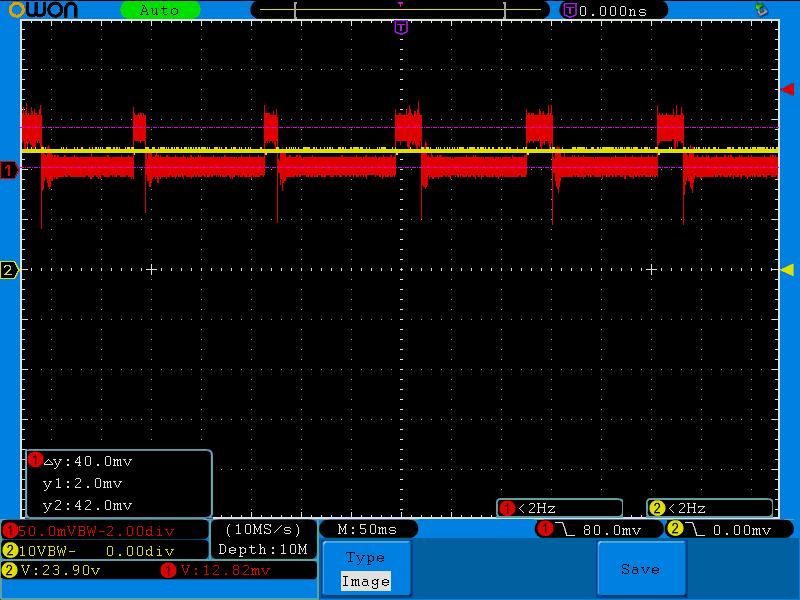
So, we have >9A current swings on a relatively high frequency PWM, and, during initial heating, a sustained period of pulling over 10A from the supply. If you are printing ABS, you could have a couple of minutes of running at >100% of the rated capacity. I'm not power expert, but its no wonder the silly thing ticks. Since this is a auto-ranging/active PFC supply, there is a front end likely has a boost converter that has to work a good bit on a 120V grid. I haven't taken the lid off yet, but I plan too. I expect the components are just enough for the rated capacity and at 120-130% over rated input capacity, some number of them are just giving up the ghost....
I'd really like to see the AC current waveform, but I'm not sure it's worth the $65 for a current probe...
I've got a MEAN WELL LRS-350-24 to replace it with. For those that that have used this, or the NES-350, one of the things to note, and one of the reasons it's cheaper is that it isn't an auto-range, active PFC supply, so it doesn't have all the extra components for the front end boost converter. It's also quite likely that its the boost converter that is ticking and blowing up. The MEAN WELL supplies likely just have the switched voltage doubler for running on 120V power. One of the reasons I point this out is people have been talking about how expensive the Prusa replacement supply is relative to alternatives. Not that you can't find replacement supplies for cheaper, but its not as clear cut as it might appear.
Re: Power Supply failure
Those are some interesting results William. It definitely confirmed my thoughts. I too am not an expert, but I also feel running at max rating is not the best thing to do. Having a buffer of a couple of amps always feels safer to me, but I don't have anything to back that up.
One of the reasons I went with the RSP series, rather than the NES or LRS series is exactly what you mentioned.
The RSP series is auto-range for input voltage (ie: no switch) and also active PFC ( PF > .95)
However, as you mentioned, these functions come at a cost.
The RSP-320-24 (320W) is double the cost of the LRS-350-24 (350W). So, you do lose a bit of power and pay more for the RSP series, but you are gaining those extra features as well as you're still adding about 3.4 amps over the stock PSU.
Great work at meetering those stats! Thanks!
Re: Power Supply failure
Sorry, but if a 300W device let your light flicker, then you should check your home electrical wiring. It means you do have a voltage drop below 110V sometimes (for example if fridge starts running or dish washer or any other high drainer. That shouldn't happen, doesn't matter if this 300W is a printer or a coffee machine. And what you describe fits perfectly to my assumption what I've said.
Exactly right. Add to it that lights are supposed to be on a separate circuit from outlets and we see there are other problems in the home wiring. Quite possibly the outlet wiring is using 14-2 instead 12-2, since it is wired up with the lights and lights only require 14-2 wiring (due to the much lower load placed on the circuit).
Re: Power Supply failure
I re-checked my DC measurements using the current probe and the came out reasonable the same as using the shunt resistor. I couldn't use the shunt resistor to measure the AC as there was enough offset between ground and neutral that it would trip the GFCI breaker. It was only about 0.4VAC, but those things are pretty sensitive. So, on to the current probe measurements. These were at 1mV/100mA ratio on the probe.
Here is the AC side during bed and extruder heating. DC output will be about 10.5A.

So its pulling 2.8A RMS on the AC side. If I am doing my math right, thats 75% efficiency
Once the bed and extruder are at temp and go into PWM regulation, this is what AC input looks like.
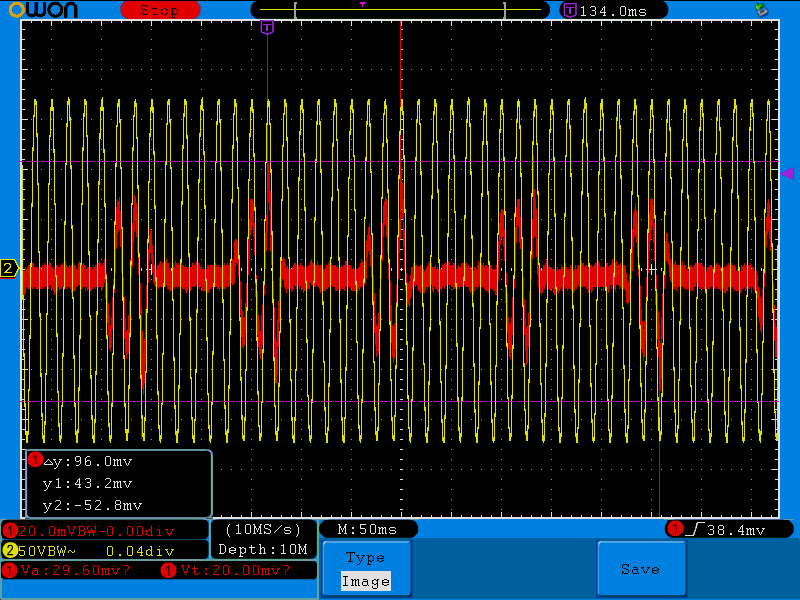
Input current is peaking at 3.36A RMS.
I did notice how nicely lined up current and voltage are. This supply has active PFC, and it shows. Especially when you look at the waveforms from the MEAN WELL.
Speaking of the MEAN WELL, here it is under full load (bed and extruder heating).
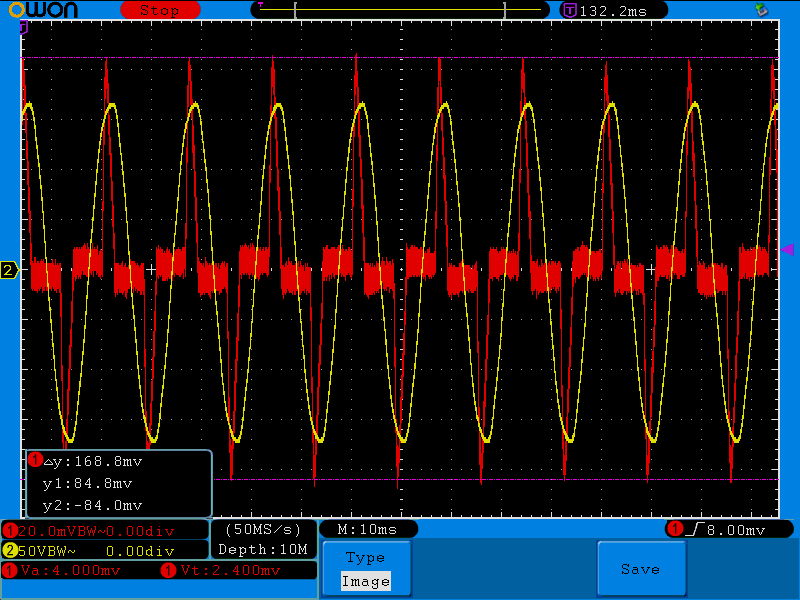
RMS doesn't apply here due to the current waveform. Input current is 8.4A. Notice the waveform. The supply does not have PFC correction.
Once the bed and extruder are in PWM management.

I haven't taken apart the stock Prusa supply, but there is nothing in the external measurements that hints at it misbehaving. It just looks like its running at or beyond its max specs.
Re: Power Supply failure
Sorry, but if a 300W device let your light flicker, then you should check your home electrical wiring. It means you do have a voltage drop below 110V sometimes (for example if fridge starts running or dish washer or any other high drainer. That shouldn't happen, doesn't matter if this 300W is a printer or a coffee machine. And what you describe fits perfectly to my assumption what I've said.
Exactly right. Add to it that lights are supposed to be on a separate circuit from outlets and we see there are other problems in the home wiring. Quite possibly the outlet wiring is using 14-2 instead 12-2, since it is wired up with the lights and lights only require 14-2 wiring (due to the much lower load placed on the circuit).
The lights in my hobby room pulse in time with the tics coming from the power supply. See the AC waveform in my prior post, no voltage drop. The lights however are a large integrated 4000 lumen unit. Something about the Prusa supply is interacting with the LED driver. I should also note that the LED driver injects noise on the AC light when it is on but dimmed, when I normally keep it.
Note the little spikes on the peaks of the AC waveform. Those are coming from the LED driver and disappear if I turn the lights off, or up to 100%.
For anyone with incandescents, you aren't going to see blinks with the bed PWM as it's too fast. Incandescent bulbs just don't respond that fast. If the printer is causing a voltage sag, you would see it during bed heating as lights dimming.
Anyway, I'm not discounting poor wiring and voltage sags. I've seen some pretty crappy wiring in houses. Simply pointing out that "simple" lights aren't so simple anymore and stuff can interact in weird ways.
Re: Power Supply failure
Thank you for the fine set of measurements.
For comparison, I've made some measurements on my MK3, running on 230V:
All measurements have voltage in green, and current in red.
Probe attenuation factors have been corrected for in the scope. Measurements on the screenshots are the real numbers.
First some measurements on the DC side.
Here is the inrush voltage and current at power on (no heating):
The inrush current when turning preheat on is hitting a peak of 10.66 A before settling down to 9.5 A. Using a 10 A supply is a very marginal design choice in my opinion:
Here we have current as PLA temperatures have been reached, The voltage is now AC coupled to see the voltage dips. The voltage has a variance of 418 mV, or 1.7%. Given the high step loads, this could have been much worse.
And now we'll have a look at the AC side of the PSU.
First the inrush current at printer power on (no heating):
Here is the steady state current when the printer is idle. Note that the active PFC is not doing a good job at this low load (not that I was expecting it to):
Preheating from cold. Power consumed is about 244 W, and output on DC side (not shown) is 228 W, resulting in 93% efficiency:
When the PLA temperature is reached:
And a closeup of a current peak:
Conclusion: It does seem this Prusa PSU behaves quite well on 230V, though using a 10A supply is really pushing it to the limit (and then some).
I will continue to use mine, but if/when it does go belly-up, I do have a 24V / 12.5A Siemens industrial PSU ready to take over.
Re: Power Supply failure
Here is the AC side during bed and extruder heating. DC output will be about 10.5A.

So its pulling 5.6A RMS on the AC side. If I am doing my math right, thats like 37.5% efficiency 😮
I wasn't doing my math right... 😳
In the above, it's pulling 2.8A RMS for about 75% efficiency. Going to go back an correct my post.
Re: Power Supply failure
I had my second power supply failure last night. My first PSU lasted about 3 months. The new one failed after 3 weeks of printing ASA most week days. I started a chat with Douglas from support this morning and he pretty much blew me off and said to email [email protected] for further guidance. I have 4 other printers from different vendors that have never failed in the same room. All of them are on a big server room UPS and we have reliable power in the business park.
The failure is exactly the same as the last one with a blown PSU fuse and no DC output after fuse replacement. When I replaced the first PSU, I did not mount the new one to the frame rail. I kept it pulled away from the printer, so the heatbed wouldn't put an additional heat load on it. The ASA prints at 265/110C, so my guess is this too much for the stock PSU. I checked everything with my Fluke DVM and all the power inputs looked good and there were no shorts detected on the printer. The fuses in the EINSY were all good and all of the wiring looks fine and is carefully routed. Nothing smelled burnt on either failed PSU.
Douglas said it could be the EINSY or PSU and I would need to email them for further guidance, but I don't get how they will determine my EINSY is in question if the PSU is bad other than very basic DVM checks. The first time the PSU went bad support chat was very helpful. I just bought the printer July 22. I am debating putting a bigger PSU on that has current limiting, since they aren't offering me a replacement right away.
-Chris
Re: Power Supply failure
DVM checks will tell you if there is 24V present on both outputs, which is all you need to know.
If you want to continue using the standard PSU you can but my opinion is that you need to modify the standard GCODE that comes with Slic3rPE and change the lines for the bed heating and nozzle heating so they they don't operate in parallel during the heat up cycles.
In the printer settings tab
Change this
M104 S[first_layer_temperature] ; set extruder temp
M140 S[first_layer_bed_temperature] ; set bed temp
M190 S[first_layer_bed_temperature] ; wait for bed temp
M109 S[first_layer_temperature] ; wait for extruder temp
To this
M140 S[first_layer_bed_temperature] ; set bed temp
M190 S[first_layer_bed_temperature] ; wait for bed temp
M104 S[first_layer_temperature] ; set extruder temp
M109 S[first_layer_temperature] ; wait for extruder temp
If you're planning on high temperature printing such as Nylon or PC then personally I'd be looking for a different PSU of at least 350W but finding one without a fan won't be easy. I replaced mine months ago although the original is still fine, I used a Meanwell RSP-500-24 which does have a fan but it only ran when the temperature exceeded 50°C internally. I built/printed a shroud for it though and fitted a super silent 24vdc fan which ran all the time the printer was on and pulled air through the PSU - so the internal fan never ran unless ambients went beyond 25°C. What I run now would be considered OTT but I have my reasons (PULS 20.111 20A).
The previous posts showing performance really confirmed suspicions that the PSU isn't appropriately specified, I'm guessing that keeping it fanless was the reason. I ran my printer through a lab PSU and at some points it peaked at 12.3A (295W) - which is way beyond the 240W or so that the Prusa PSU is rated at, the standard supplied PSU was never used again. In the company I work for all PSU's are deliberately overrated by at least 50% simply to allow for derating in different ambients, you can't design 'on the limits' unless you have some control over how and where the device gets used.
I don't know how far you go with the blame game as Joe had to get these out at a price that would sell. High end PSU's can cost almost as much as the printer did on their own, I reckon Joe probably got some bad advice, he doesn't come across as the type that would knowingly put his reputation at stake. What he should do though is uprate any that he replaces with a unit capable of at least 15A @ 24DC - 350W would do - but then finding one without a fan - there's the challenge.
Re: Power Supply failure
I had my second power supply failure last night. My first PSU lasted about 3 months. The new one failed after 3 weeks of printing ASA most week days. I started a chat with Douglas from support this morning and he pretty much blew me off and said to email [email protected] for further guidance. I have 4 other printers from different vendors that have never failed in the same room. All of them are on a big server room UPS and we have reliable power in the business park.
The failure is exactly the same as the last one with a blown PSU fuse and no DC output after fuse replacement. When I replaced the first PSU, I did not mount the new one to the frame rail. I kept it pulled away from the printer, so the heatbed wouldn't put an additional heat load on it. The ASA prints at 265/110C, so my guess is this too much for the stock PSU. I checked everything with my Fluke DVM and all the power inputs looked good and there were no shorts detected on the printer. The fuses in the EINSY were all good and all of the wiring looks fine and is carefully routed. Nothing smelled burnt on either failed PSU.
Douglas said it could be the EINSY or PSU and I would need to email them for further guidance, but I don't get how they will determine my EINSY is in question if the PSU is bad other than very basic DVM checks. The first time the PSU went bad support chat was very helpful. I just bought the printer July 22. I am debating putting a bigger PSU on that has current limiting, since they aren't offering me a replacement right away.
-Chris
A couple of notes. First may be obvious to some, not others. The printer doesn't pull different amounts of current depending on the material being printed. Regardless of the temperature settings of the bed and extruder, it's going to pull 10-11A from the power supply. The difference comes in the PWM signal. A higher temp will result in that current being pulled for longer pulses. Cold environments will have a similar effect as the printer needs to work harder to keep things at temp.
As to replacing with a larger supply... I went with the LRS-350-24 and, at least for me, it is a much noisier/louder power supply. When the cooling fan kicks in, it pretty much drowns out the rest of the printer. When idle, the switching noise is noticeably louder than it was on the Prusa supply. It's not annoying or anything and you can't hear it unless you are near the printer, but it is definitely there.
